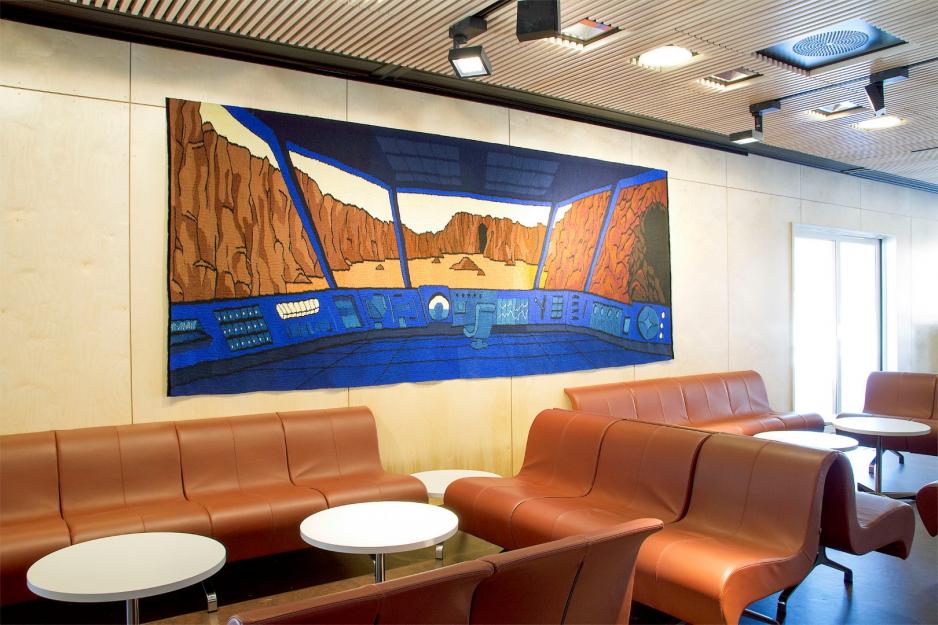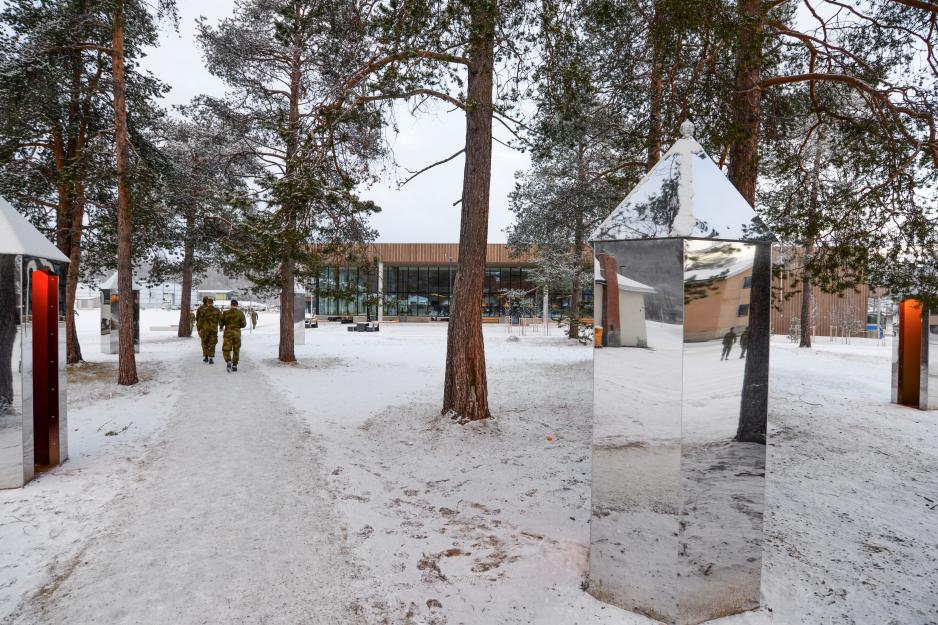Will We Be Safer Up North if the Armed Forces Tear Art Down from the Wall?

‘The Blue Control Room’ by Kristin Sæterdal is currently located at camp Jørstadmoen. The Conservative Party’s program committee suggests removing art from future Armed Forces buildings as part of its defense policy. (Photo: KORO, the Office of Arts i Public Spaces)
Commentary: In an interview covered by High North News, NATO Secretary General Jens Stoltenberg describes clear and increasing military activity in the Arctic. The question is how Norwegian politicians respond to this analysis. Some of the answers can be found in the respective Arctic strategies of the Conservatives and the Labor Party.
In the interview, Jens Stoltenberg points at three security policy trends in the Arctic.
Firstly, he sees increased Russian military activity in the form of deployment of new weapon systems, reopening of old military bases and more military exercises.
Secondly, he also sees increased Chinese presence in the High North, amongst others in cooperation with Russia. China invests in infrastructure in the Arctic and has, overall, significantly increased its fleet capacity in recent years.
The most dangerous weapons
The third trend in the North comes in the form of what Stoltenberg describes as a response from NATO. This means more military exercises and increased military capacity on land, at sea and below the surface.
The most dangerous weapons are found under the ice
Nevertheless; all in all, the NATO Secretary General hopes for continued low tension in the Arctic, yet he takes the opportunity to remind us that “the most dangerous weapons in the world are found under the ice”, this referring to the fact that most of Russia’s nuclear submarine capacity is located at the Kola Peninsula.
During the past weeks, both the Conservative Party and the Labor Party have presented their draft proposals for an Arctic strategy. Both are concerned with the security policy situation in the High North.
24 pages or 24 lines
Where Labor has presented a 24-page document about the High North, the Conservatives settle for 24 lines.
I do not know how many of the proposals from Labor’s Arctic Policy Committee that will survive when they are to be incorporated into the overall party program. Nor do I know whether the more modest engagement from the Conservatives will be adopted at its annual meeting this weekend.
In the Labor Party’s draft program, a full chapter covers challenges related to security politics.
In the Conservatives’ draft program, the security policy section of its Arctic policy is covered in four bullet points.
In addition, the Conservatives have a separate chapter about security policy in general. Labor will probably end up with the same in its program, and I therefore do not conduct any review of the overall defense and security policy this time.
This is about the High North.
Most important area
Both the Conservatives and Labor initially state that the High North is “Norway’s most important strategic area”. The Conservatives add that the High North is also Norway’s “most important security policy region”.
So what consequences do the country’s two largest parties draw?
The High North is thus not just strategically important, according to our two largest parties.
It is The Most Important Area.
So what consequences do the country’s two largest parties draw from their own clear emphasis on the security policy importance of the High North?
The Conservative proposal
The Conservatives initially write that they want a security policy “based on deterrence and reassurance with increased military presence in the High North”. The point is repeated in the very first bullet point, which states that the Conservative Party wants to “strengthen the Armed Forces’ presence in the Arctic”. In addition, the party wants to maintain what it refers to as “Norway’s lead role in low tension in the Artic” through cooperation in the Arctic Council.
The Conservatives also want to “maintain good neighborly relations with Russia”.
In order to reduce tension and increase understanding between peoples, the Conservatives want to “strengthen and further develop people-to-people cooperation in the High North”.
In the chapter ‘A Strong Defense’, the Conservatives remind us that “Norway maintain’s NATO presence in the High North and NATO provides security for Norway”.
China’s position in the High North is not mentioned in the Conservative program.
The Labor Party proposal
The Labor Party proposal is more analytical and goes more in-depth on security policy challenges related to the High North. Increased interest from “big powers like the USA, Russia, China and the EU” is mentioned, amongst others.
Labor also uses the term ‘deterrence’, however, it also focuses heavily on Norway’s peacekeeping role. It says that “taking the lead in continued peaceful development is preconditioned on presence. People simply have to live in the High North and there should be activity.” Peacebuilding work is to be strengthened, amongst others through increased institutional cross-border cooperation.
Foreign and security policy dialogue is to be strengthened too, and new meeting places created. Amongst others, there is a proposal for a “joint Center for Arctic strategic studies by the University of Tromsø and Nord University”. Existing meeting places such as e.g. the Barents Secretariat and Arctic Frontiers are amongst initiatives to be strengthened. As is the border area cooperation with Russia.
Labor’s ambition is “strong and modern Armed Forces with its center of gravity in the High North”. This is also where “key management functions should be located”. The defense of Norway should be “strong and predictable”, it reads.
Why do soldiers not need art?
In summary, the Labor Party’s chapter about security policy in the High North is more extensive and more specific than the Conservatives’ accumulated draft Arctic policy.
Kick out the arts
The most concrete and committing proposal in the Conservatives’ security policy is perhaps the requirement to remove “the requirement that a portion of the construction budget should be spent on art when the buildings have military purposes or are to be operated by the Armed Forces”.

Art also characterizes the Armed Forces in the High North. This is from Camp Rusta, Bardufoss. ‘Quis custodiet ipsos custodes’ by Dyveke Sanne. (Photo: Halvor Bergan/KORO)
“Art and the experiences it facilitates enriches us as humans. Art and culture are a part of our national infrastructure” says a different section of the Conservative’s proposed program. The program does not say anything about why military personnel should not be “enriched”.
In November, the government will submit its new Arctic strategy. It should provide more answers to the security policy challenges pointed out by Jens Stoltenberg than what the Conservative party is able to when it holds its annual meeting this weekend.
Removing art from the walls of the Armed Forces is not a step in any direction at all.
This commentary was originally published in Norwegian and has been translated by HNN's Elisabeth Bergquist.

